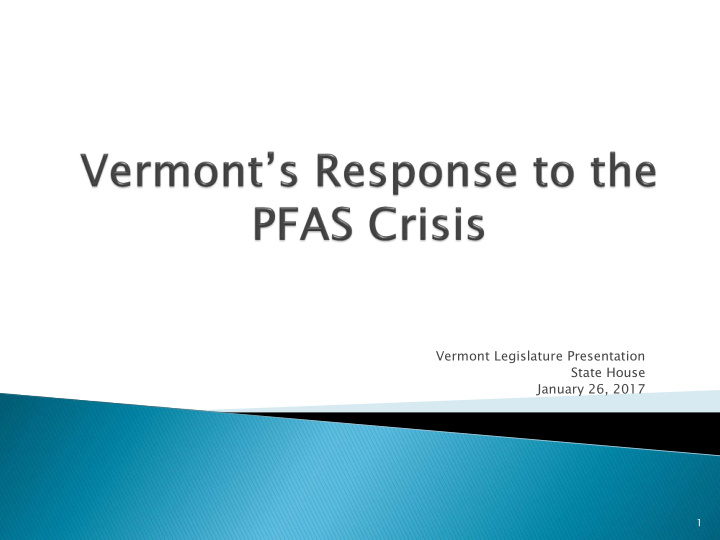



Vermont Legislature Presentation State House January 26, 2017 1
What are Perfluoroalkyl Substances (PFASs) (PFOA) & (PFOS) What are their Health Effects Review current sites with PFASs ◦ North Bennington/Bennington/Pownal Review Statewide Plan Review challenges Share lessons learned 2
PerfluoroOctanic Acid (PFOA) Perfluorobutanesulfonate (PFOS) 3
What are PF PFASs Ss in in? ∙ Teflon production ∙ Electronics coatings ∙ Scotchguard/Gortex ∙ Fire fighting foam (AFFF) (PFOS) ∙ Textile coating (Chemfab) (PFOA) PFASs Ss Healt lth Effec ects ts ∙ Concentrates in Blood Serum ∙ May cause hypertension, low birth weight, some immune systems effects, thyroid disease, kidney cancer, and testicular cancer ∙ Vermont Health Advisory at 20 ng/l g/l (ppt) for PFOA/PFOS combined 4
5
6
Initial PFOA Results 50 samples • 22 results : ND • 9 results : 0-20 ppt • 8 results : 20-100 ppt • 11 results : > 100 ppt • Immediate notification to sampled parties Governor’s Press Conference Public Meeting 7
8
Bennington PFOA Private Well Results • 551 samples collected from private wells >60% of all wells had some level of PFOA • 203 results : ND (37%) • 79 results : 0-20 ppt (14%) • 269 results : >20 ppt (49%) ∙ Rece cent t Re-sam amplin ing g effo forts ts have ve changed nged these resul ults ts 9
10
Surface Water/Sediment Results Surface Water (10 samples) • Results ranged from ND – 79 ppt (additional samples • taken by Bennington College show higher levels) Sediment (7 samples) • 4 samples ND • 3 samples ranged from 1.2 – 2.4 ppb • Results show no risk to human health or most sensitive • aquatic species Fish Tissue samples collected, results show PFCs in Fish, but • not at a level of concern 11
12
Soil Results Collected over 100 samples • Results ranged from ND – 45 ppb • Majority of results < 10 ppb • VDH soil screening level : 300 0 ppb • Surface soil remediation • deemed not necessary for direct contact 13
Gardening and Farming Do not expect to find measurable levels of PFOA in produce • Recommendations • Use clean water for irrigation • Amend soil with clean compost • Wash your produce after harvest • Peel root vegetables • Livestock • Should be given clean water • Maple Syrup Tested free of PFOA ! • 14
Sludge and Septage Sampling Collected sludge samples from WWTP and septic tanks • Results from WWTP influent 350 ppt • 5 pressed sludge samples from WWTP • Average 8 ppb • 3 septic tank samples showed PFOA and PFOS • SPLP (leaching study) shows PFASs in water • Compost shows no PFASs in compost sample • some PFASs in SPLP sample • 15
16
Getting Homes Clean Water ∙ Bottled water delivered immediately to all residents • 11 homes/business connected to municipal system where water line nearby • 255 systems Point of Entry Treatment (POET) systems installed • Connecting to municipal system is best long term solution 17
VDH Blood Testing • VDH tested more than 400 people • PFOA in blood 0.3 – 1,126 ppb • Average for Bennington – 10 ppb • 2.1 ppb – United States average • 33 ppb - Ohio workers • 1,130 ppb – Alabama workers PFOA half-life in blood: 2-4 years • 18
∙ State sampled 551+ drinking water wells ∙ POET systems installed on all wells >20 ppt ∙ POET systems sampled 3 times, O&M Manual ∙ Resampling performed for wells ND or <20 ppt ∙ Soils sampled around the former Chemfab ∙ Surface water, sediment, and fish sampled ∙ Maple syrup, milk, garlic (planned) sampled ∙ Facility Site Investigation performed, no results ∙ Engineering Study for Municipal Water line extension North Bennington and Bennington ∙ Evaluation for Treatment of Groundwater (CSM) ∙ Negotiation for Universal Site Consent Decree 19
20
21
Statewide PFOA Response Reviewed limited state information on use of PFASs • Prioritized industries to target • Semiconductor, wire coating, fire fighting training centers • Also prioritized based on sensitive receptors (# of drinking • water wells within ½ mile of facility) Phased sampling over 4-8 week period • 11 Locations chosen for sampling • Results showed 6 of these sites have PFASs released to the • environment Include IBM, Air Guard Base, Pittsford Fire Training Center, etc • 22
Challenges to PFOA Response Magnitude of effected area • Developing health advisory levels for water, soil, crops, fish, • etc. Messaging of health advisory level in Vermont • Blood sampling results • Understanding the fate and transport • Presence of Arsenic from point-of-entry treatment systems • Superfund sites – do we reopen? • 23
24
Lessons ons Learn rned ed • 2-1-1 support • Importance of immediate public meetings • Weekly emails to community • Importance of establishing clear Incident Command Structure • (assistance from VEM, DOH, Ag) • Importance of reaching out to neighboring states • (NY, NJ, NH, MN) 25
Contact information: Richard Spiese 802-249-5083 richard.spiese@vermont.gov 26
Recommend
More recommend